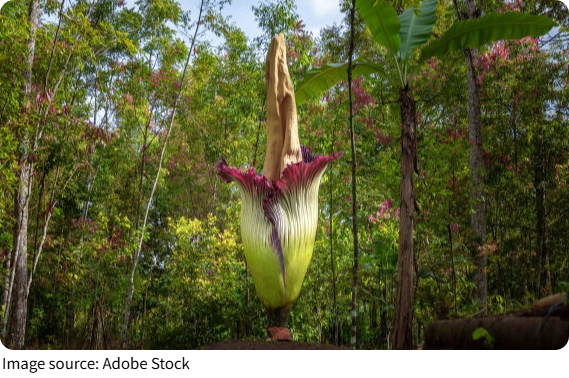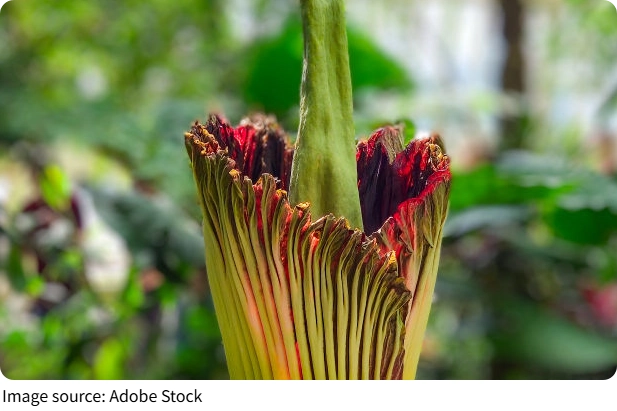The Stinky Giant

Have you ever wondered about the weird and wonderful world of plants? Some plants are beautiful, some are useful, and then there's Amorphophallus titanum, more commonly known as the "corpse flower."
This is a plant that doesn't just catch your eye—it grabs your nose as well.
Known for producing one of the foulest odors in the plant kingdom, the corpse flower's unique biology and behavior make it a fascinating subject for botany enthusiasts and curious minds alike.
In this article, we'll explore the striking features of Amorphophallus titanum, its unusual pollination strategy, and why it has become such an iconic and mysterious plant in the world of flora.
What is the Corpse Flower?
The corpse flower is a tropical plant native to the rainforests of Sumatra in Indonesia. It's most famous for its enormous flowers that can reach up to 2.5 meters in height, making them one of the largest flowers in the world. But the sheer size of the flower isn't the only thing that makes it stand out—it's the smell.
When the flower blooms, it emits a potent odor, often compared to the smell of rotting flesh. This foul scent is not a mistake; it's a key part of the plant's strategy to attract pollinators. But the smell is just one piece of the puzzle in understanding how this unusual plant operates.
The Flower's Unique Structure
The bloom of the Amorphophallus titanum is an event in itself. It opens up to reveal a spadix (a central spike) surrounded by a large, petal-like structure called a spathe. The spathe is initially green, but it turns a deep purple or red as the flower opens. Its impressive size and shape give it an almost theatrical presence in the plant world.
But the structure isn't just for show. The spathe helps the flower trap heat, which is part of the reason why the odor can be so overwhelming. The heat, combined with the strong smell, mimics the environment where the plant's natural pollinators—primarily carrion beetles and flies—are most active. These insects are typically attracted to the scent of decaying organic matter, and the Amorphophallus titanum is an expert at mimicking that smell to draw them in.
The Smell: A Pollination Strategy
Now, let's talk about the smell. It's certainly the most famous feature of the corpse flower, and rightfully so. When the flower blooms, it releases a pungent odor resembling the smell of rotting meat, which is why it is called the "corpse flower." But why does it smell like this?
The answer lies in the flower's pollination method. While most flowers attract pollinators with pleasant scents or nectar, the corpse flower takes a more sinister approach. It attracts carrion-eating insects that are typically drawn to the smell of decaying flesh, such as certain species of beetles and flies. These insects unknowingly assist in the pollination process as they move from flower to flower, transferring pollen along the way.
Interestingly, the flower doesn't just release the smell all the time—it only emits the rotting scent during a short, specific period of time when it's ready for pollination. This period usually lasts for just 24 to 48 hours. Once the pollination window closes, the flower stops producing the odor, and its scent fades away. This time-sensitive release ensures that the flower doesn't waste its energy attracting insects when it's not in a state to reproduce.
The Giant Bloom: A Rare Event
The blooming of the Amorphophallus titanum is a rare event, and this is one of the reasons why it gets so much attention when it happens. The plant can go years without producing a flower, and when it does, the bloom is a spectacular sight. Because of its short blooming period and the difficulty of getting the plant to flower, it has become a sensation in botanical gardens around the world.
For a plant that can grow so large and produce such an incredible bloom, the Amorphophallus titanum actually has a fairly short life cycle in terms of flowering. It usually takes several years, sometimes up to a decade, for the plant to mature enough to produce its iconic flower. When it does bloom, it's a big deal—botanic gardens and plant enthusiasts eagerly wait for the rare opportunity to witness it.
Why Does It Smell So Bad?
The smell might seem like an unpleasant feature of the Amorphophallus titanum, but it's actually a brilliant evolutionary adaptation. The flower relies on a very specific group of pollinators—carrion beetles and flies. These insects are typically attracted to decaying organic matter, which they use as food or breeding grounds. The plant's ability to mimic that smell ensures that it attracts the right pollinators at just the right time.
Furthermore, the foul odor helps the plant avoid attracting the wrong type of insects. If it were to produce a sweet or pleasant smell, it might attract pollinators that are less effective in the transfer of pollen, such as bees or butterflies. By sticking with the "rotting flesh" scent, the plant ensures that its pollinators are well-suited to its needs.

Conclusion: The Mystery of the Corpse Flower
The Amorphophallus titanum is one of the most fascinating and mysterious plants in the world. From its giant size to its foul-smelling bloom, it stands out in the plant kingdom as a true marvel of nature. The way it attracts pollinators with the scent of rotting flesh is a brilliant survival strategy that has allowed it to thrive in its native environment.
While the odor may be off-putting to us, it's essential for the plant's reproduction. The fact that the Amorphophallus titanum only blooms once every few years and for such a short period of time makes it a rare and extraordinary spectacle. It reminds us that nature often operates in ways we don't expect, with plants using everything from size to scent to survive and thrive.
Have you ever witnessed the blooming of a corpse flower? Or perhaps you've read about it online? Feel free to share your thoughts and experiences with us—let's keep the conversation going!


